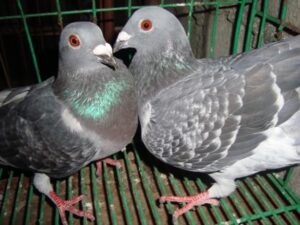 I like to pair my birds so that there’s always a genetic link between two pigeons. The studies I‘ve done on the subject really back this up. I’ve spent countless hours studying genetic percentages. I’ve found that there seems to be a common denominator between 28% and 37% common blood and a high degree of success in racing, and also in breeding. Especially linebred pigeons kept at a linebred coefficient of between 28% and 34%, or sometimes higher, seem to have more consistency in winning races than either outcrosses or birds that are inbred or linebred closer than that.
I like to pair my birds so that there’s always a genetic link between two pigeons. The studies I‘ve done on the subject really back this up. I’ve spent countless hours studying genetic percentages. I’ve found that there seems to be a common denominator between 28% and 37% common blood and a high degree of success in racing, and also in breeding. Especially linebred pigeons kept at a linebred coefficient of between 28% and 34%, or sometimes higher, seem to have more consistency in winning races than either outcrosses or birds that are inbred or linebred closer than that.
I try to find a dominant gene pigeon, a bird that has proven itself to be a super breeder or racer, and I prefer a super breeder that was also a super racer. Line breed at about a 31% ratio to that particular pigeon. This is the exact ratio of my bird that won 6th place at the Snowbird race and was also the 6th overall best pigeon in the Snowbird race and Snowbird futurity combined last year. It’s also the same percentage that was successful for me in some of the local futurities and the New Orleans Open Classic. It’s proven itself in my loft over many years of racing and keeping these records. In comparing it to outcross birds, in other words, those with no common ancestry within 6 generations, it is much more successful.
Often, outcrossing is just a shot in the dark. You can sometimes have fantastic success, but also a much higher degree of uncertainty or of complete failure with outcrossing. Why do people do complete outcrossing then? Because of the hybrid vigor that can sometimes result. If you pair two inbred pigeons that have no relation at all, you can sometimes get a boost called hybrid vigor. The percentage for success is around 17% or between one in five and one in six, according to the Europeans. A fabulous exception to this is finding a “nick pair” that gives you a much higher percentage of success. But generally, two complete opposites will give you between one in five or one in six success with a good bird.
With linebred pigeons from a good origin, the percentages go up to anywhere from one in four to one in three. So you have much higher odds for success with steady pigeons through linebred pairings. In some situations, a complete outcross pigeon will become a superstar, because it has not only the hybrid vigor but also the combination of genes that allows it to be a steady racer. And the hybrid vigor allows it to be a steady, great racer. So sometimes the outcross is a worthwhile effort. We do this to some extent every year, especially if we want to introduce one of the outcrosses back into one of the existing families later.
Using outcrosses that have a known probability of nicking is one way to reduce the uncertainty of combining two families. An example of one of these combinations is the pairing of Huyskens Van Riels with the Haveniths, which is done quite a bit in New Jersey. Many people know that Janssens have proven to be great crosses with many families. The Stoces with Grondelaers is another natural nick. One of the best natural nick pairs is the Golden Couple from Meulemans with Van Den Bosche blood crossed with Janssen blood. That produced an entire family of great birds based on an outcross pairing.
So there can be great value in pairing complete outcrosses with one another, but you increase your chances of success if you have some idea of the crosses that have been done and proven with success before. Some families of birds crossed with others have no success at all. The average combination seems to be no better than one in five or one in six.
We like to do a majority of our pairings linebred, but when we have a very inbred bird, in other words where we’ve made a combination of father-daughter or mother-son and produced a very inbred progeny, we like to cross that progeny to a completely different family. We do the father-daughter, mother-son pairings because we have found that when we take a very successful racer out of a super breeder and pair that successful racer back to its parent, we often get above average and sometimes even great breeders. If it’s a successful cock, we like to pair it back to its mother. If it’s a successful hen, we like to pair it back to its father. We try to race their young ones, and we don’t ask those young ones to be as successful in the races as we would expect an outcross to be, because those babies don’t have the advantage of having hybrid vigor.
We set a different standard and set of goals for the inbreds than for the linebreds and outcrosses. If they meet these goals, which are basically to be a good homing pigeon, be a steady racer, show some intelligence in coming home in a decent time (not necessarily win the race or even score a diploma, but come close) then we would consider that an indicator that this bird has ability and intelligence and should be given a chance as a breeder. We cross these to other families that we’ve done the same thing to, one that we already know would be a good nick with the first family.
In 1998, we took our best Horemans hen and bred her to her son From that pair we raised four babies and raced all of them. Two did fairly well, never winning but coming in good time. We bred from three of them in 2000. The ones that did OK in the races have both produced excellent clock birds for us. The one that did not race well has not. It’s something we’ve always done and will continue to do. We’ve had a great deal of success with it. Now we’ve found two future breeders for our loft, and they’re young, only ‘98s, so we know that we’ve got a young breeder that we can go with for a long time to give us a percentage of good pigeons every year.
So to summarize, we look to pair genetically linked pigeons, or we look for a complete outcross if we’re dealing with two fairly inbred birds. If we’re not dealing with an inbred pigeon, we prefer to line breed them because chances of success are greater. We’d outcross a bird that is heavily inbred. We’d line breed a bird that is not so heavily inbred or not inbred at all.
How are the inbreeding coefficients calculated? If you look at a 5-generation pedigree, the father and mother are considered to be equally responsible for the gene pool of the young one, so the pigeon in question gets 50% of its gene pool from the father and 50% of its gene pool from the mother. The offspring also gets 25% of its gene pool from each of its grandparents. 12.5% each from its great-grandparents, 6.25% from its great-great-grandparents, and 3.125% from its great-great-great-grandparents. This is as far as you need to go to figure out the genetic linkage.
I take the common genetic link between the father and the mother to figure out a bird’s genetic coefficient. If a bird is from inbred pigeons on only one side of its pedigree, its inbreeding coefficient is zero. But if it has common ancestors in the father’s and mother’s sides, or top and bottom of the pedigree, it has an inbreeding coefficient. How high that coefficient is, is just a matter of adding up the percentages.
Check out part 1 => Pairing Breeders Part 1 of 2


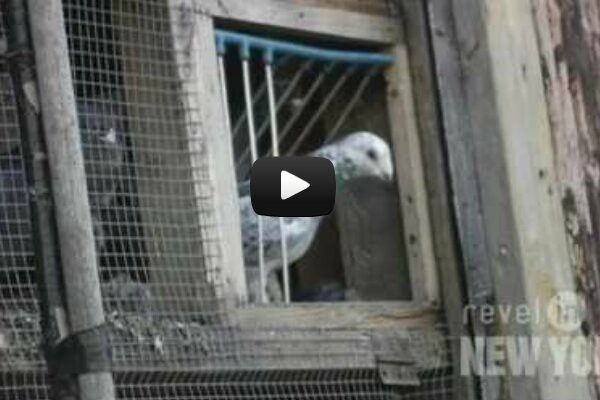
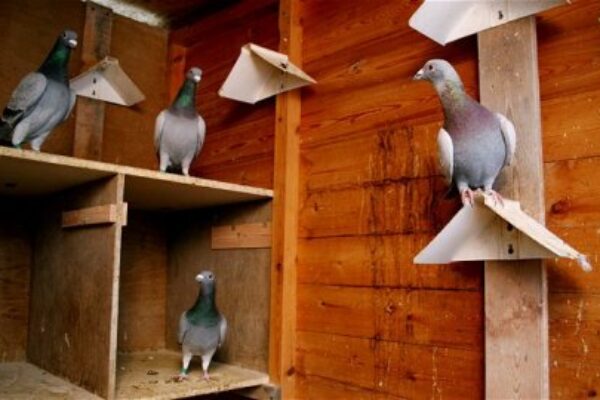
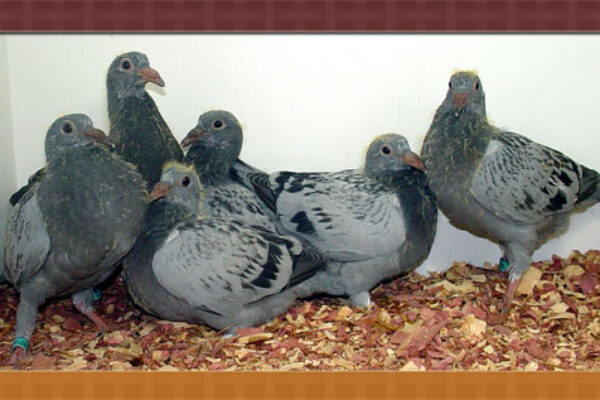
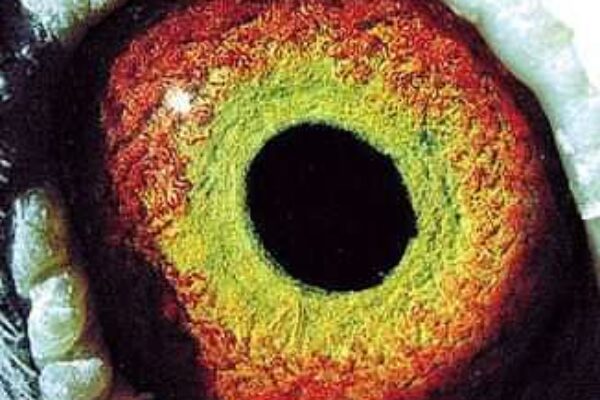
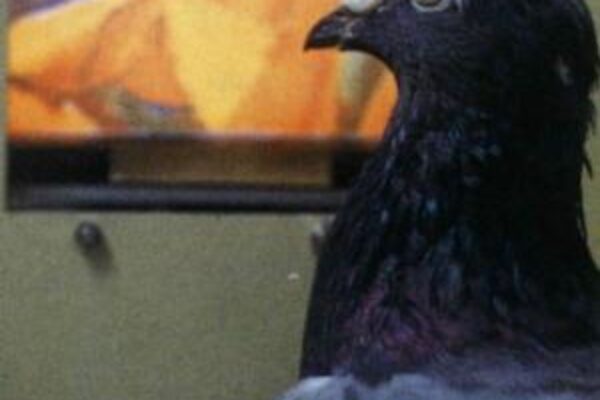


I can’t get this one bird out of my mind. On Sep 7 I saw a hobbled bird across the street at my neighbor’s sidewalk curb. The bird was making its way slowly and I didn’t intervene because I figured it belonged to the neighbor. About a half hour later I went back out front to water my plants and saw the bird tucked against my bottom step. I was stunned, it was so quiet and still, looking at me intensely. I realized it was the same bird from across the street, and saw the reason for its limp: a band around its leg had caught up it’s “thumb”. I was just heartbroken for the little thing. It had two bands, one on each leg. I went to get some water for her, it was a terribly hot day. When I came back with the water she had already made her way under my porch. I placed the water dish close by her and she drank with huge gulps. I’d never seen a bird so thirsty.
I had some keet food left over from my parakeet family, so I brought her a dish of that as well. When I checked on her I saw she was digging into the keet food. I was in a real quandary because I wanted to get her to a bird rescue nearby but my schedule was already full as I was preparing to leave for a beach vacation and the day was totally booked. I told my boyfriend about her. He said she was a racing pigeon. I asked him to look in on her in my absence. During her overnight at my place, she seemed to be settling in and I looked forward to having a pet after she was cared for at the bird vet. Her little foot looked like it wasn’t go to be of much use after the band was removed. I talked to her and comforted her, and she even let me touch her gently. She was so beautiful! My brother saw her and remarked how healthy she looked. We were both used to city pigeons and had never seen a bird so healthy and fine feathered (except for the lame foot).
She seemed happy under the porch. The only threat would be a stray cat, but I’d never seen one in my community due to HOA laws. When I called my boyfriend from the beach he said there was no sign of a bird. I’d left the bag of bird feed in a closed plastic bin so he could feed her while I was gone. I guess she’d gone on to her destination. I’m happy she used my place as a rest stop and I was able to provide necessary nourishment, but I still worry about her.
Can’t humans be more careful when they place the bands on these poor creatures? And why two bands? Isn’t just one sufficient?